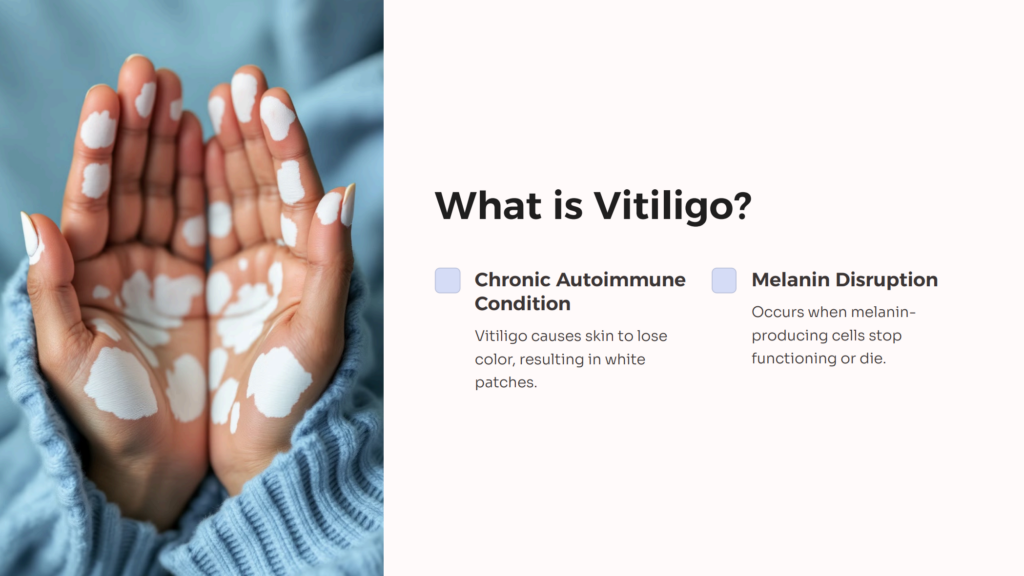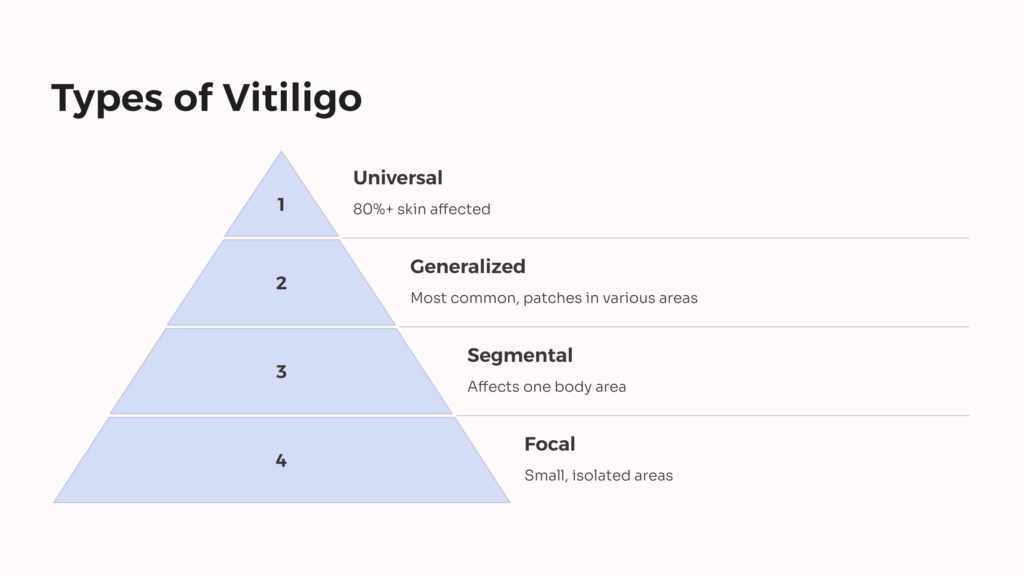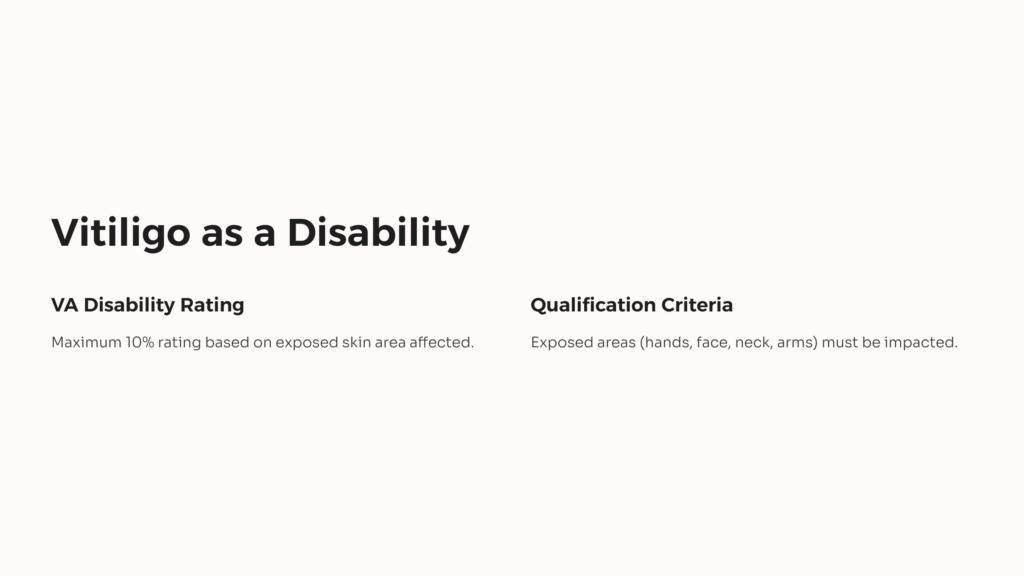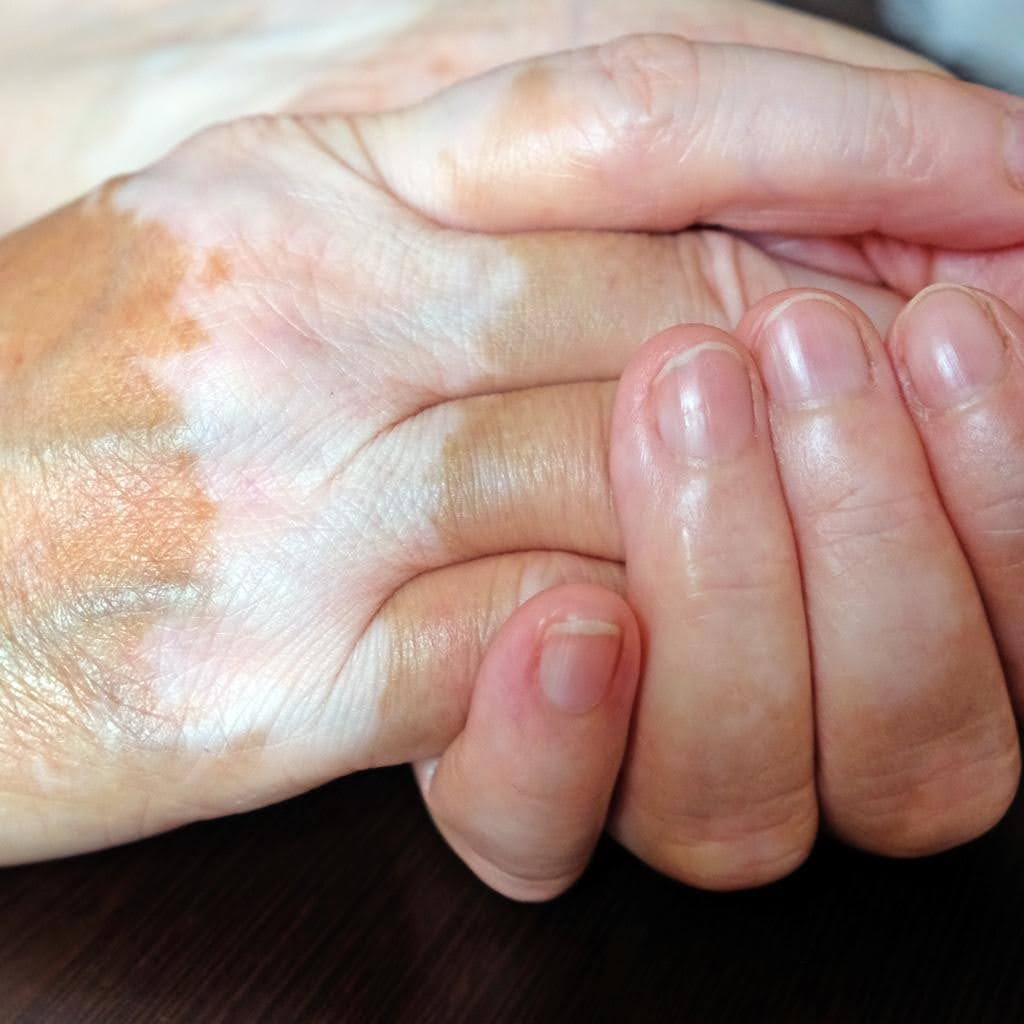If you see patches of your skin turning pale, you might wonder what is causing it. If those patches appear on your feet, hands, and even around your mouth, you might have vitiligo. This condition isn’t contagious or dangerous but can significantly impact your life.
If your condition is service-related, you may qualify for VA disability benefits. Read on to learn more about this skin condition and how you can receive vitiligo disability benefits for it.
Understanding Vitiligo

Vitiligo is a chronic autoimmune condition that causes the skin to lose color or pigment. This causes patches of the skin to turn white or appear lighter than the natural skin color. This disease can affect the skin on any part of the body, including the hair and the inside of the mouth.
Generally, melanin determines skin or hair color. This skin condition occurs when cells that produce melanin stop functioning or die. Vitiligo is more noticeable among people with Black or brown skin. While this condition isn’t contagious or life-threatening, it can make you feel bad about yourself, which can be stressful.
Signs and symptoms of vitiligo include:
- Patches of mucous membrane or skin that lose color: These patches may appear lighter or whiter than your natural skin tone.
- Premature graying or whitening of hair on your eyelashes, scalp, beard, or eyebrows
This condition can start at any age but often appears before age 30.

Based on the type of vitiligo you may have, it might affect:
- Generalized vitiligo: This is the most common form of vitiligo that causes patches in various body parts.
- Mucosal vitiligo: This type of vitiligo affects the mucous membrane of your genitals or mouth.
- Segmental vitiligo: This type of vitiligo affects one area or side of the body, such as the face or hands.
- Trichome vitiligo: This form of vitiligo causes a bullseye with a colorless or white center, an area of your natural skin tone, and an area of lighter pigmentation.
- Focal vitiligo: This rare type causes patches to develop in a small area and not spread in a specific pattern in one or two years.
- Universal vitiligo: This type of vitiligo is very rare, and it causes more than 80% of your skin to lose its natural color.
Vitiligo is caused by a lack of melanin. Research shows this skin disease occurs due to autoimmune conditions, genetic changes, environmental triggers like chemical and ultraviolet radiation exposure, and stress.
The Impact of Vitiligo
While vitiligo isn’t painful, you can still experience painful sunburns on lighter patches of your skin affected by this autoimmune skin disorder. So, it’s vital to protect yourself from the sun by using sunscreens, wearing protective clothes, and staying away from the sun during hours when it’s strongest.
Other effects of vitiligo include:
- Eye abnormalities: Those with vitiligo might experience some abnormalities in their retinas and slight color variations in their irises. Sometimes, they may experience inflammation in their retinas or irises, but their vision isn’t affected.
- Sensitive skin: Patches and macules lack melanocytes; thus, your skin might be more sensitive to the sun than other parts of your body. This may cause your skin to burn when you stay in direct sunlight instead of tanning.
- Psychological challenges: People with this skin disorder might feel embarrassed about their appearance. Some veterans diagnosed with vitiligo suffer from low self-esteem, which may cause depression or anxiety and make them to isolate themselves from others or avoid social interactions.
- Predisposition to autoimmune conditions: People with this condition are more likely to develop other autoimmune conditions that affect their immune systems. Common autoimmune disorders include anemia, diabetes, and hypothyroidism.
Vitiligo significantly affects the quality of life, especially among younger patients, by adversely affecting their careers, daily activities, and relationships. The severity of the condition worsens these effects, especially in visible areas and among persons with dark skin tones. However, long-term disease activity might enhance quality of life and acceptance.
Vitiligo as a Disability

The Americans with Disabilities Act (ADA) outlaws discrimination based on disability in public accommodations, State and local government, transportation, employment, telecommunications, and commercial facilities.
For the ADA to protect you, you must have a disability or be related or associated with a person with a disability. According to the ADA, an individual with a disability is a person who has a mental or physical impairment that significantly hinders one or major life activities, an individual who has a record of such a disability or impairment, or an individual who is viewed by society as having such a disability.
However, in the United States, the VA doesn’t automatically consider vitiligo a disability; however, it can in some instances. The VA might assign a disability rating for this condition depending on how much it affects your daily life. The maximum disability rating for vitiligo is 10%, often resulting in $165.92 in tax-free monthly benefits.
The U.S. Department of Veterans Affairs (VA) bases its disability ratings for vitiligo on how much of your exposed skin is impacted. These include areas you can’t easily cover with clothes, like your hands, face, neck, and arms. You’ll have to calculate your percentage using the 368 inches of your exposed skin and only the discolorations that fall into the exposed skin category.
If your condition affects the exposed areas of your skin, you may qualify for a 10% rating. But if your patches aren’t in exposed areas, you’ll receive a rating of 0%. That means you won’t receive any monthly benefits.
Legal Rights and Protections for People with Vitiligo

Disability protections and laws are regulations related to disabled individuals; essentially, these laws safeguard these persons from certain types of discrimination. These laws often concern housing, employment, access to public services, and education. Today, the Americans with Disabilities Act (ADA) of 1990 primarily regulates disability law.
The ADA defines a disability as a condition that meets any of the following requirements:
- A mental or physical impairment that significantly hampers one or more of the major life activities of an individual;
- A history of such impairment, or
- Being viewed as having such an impairment.
This law also requires reasonable accommodations to be made to offer persons with disabilities equal opportunities.
In addition, the Fair Housing Act prohibits unlawful discrimination in any aspect of renting, selling, or denying housing because a person is disabled. It also requires owners to make reasonable accommodations in their housing policies to accommodate persons with disability. Its standards are the same as those of the ADA.
Further, the Rehabilitation Act outlaws discrimination due to disability in federal government programs, employment practices of federal contractors, federal employment, and programs receiving federal assistance. Its standards are the same as those of the ADA.
Although vitiligo isn’t automatically considered a disability, the ADA covers dermatologic diseases. So, although individuals with vitiligo might be “considered” disabled, that could be regarded as discrimination under this law. Vitiligo is viewed as a disability if it has long-lasting effects on one’s daily activities. For instance, if it affects areas of your body that you can’t easily cover with clothing, like hands, neck, arms, and face, you might qualify for a 10% disability rating from the VA.
When assigning a disability rating for vitiligo, the VA divides the body into different parts, each representing a certain percentage of your total body area. For instance, your head represents 3.5%, each forearm represents 1.5%, and each foot represents 1.75%.
For this skin disorder, you’ll need to measure each discoloration of the affected skin and add the sizes. Next, divide the total area of your vitiligo discolorations by the total area of your skin. The VA assumes you have about 2,636 square inches of skin, with 368 square inches representing the “visible” skin with regular clothing.
To qualify for disability benefits, you’ll need an official diagnosis from a VA-approved doctor. Also, you must prove that your condition is service-related. That could be exposure to occupational hazards, stressful events, or events during your service that might have triggered vitiligo onset. Further, you must also have a medical nexus from your doctor, which links your skin condition to your military service.
The Social Implications of Classifying Vitiligo as a Disability
Society often views people with disability as “lesser humans.” There’s a perception that they don’t feel pain like others do. They don’t have the same desires, needs, or feelings as typical humans and thus aren’t entitled to the same considerations and rights as typical individuals.
So, disabled adults and children are depersonalized and isolated, and their families are often marginalized and demonized. Further, these individuals are frequently perceived as “objects” that might be exploited and even treated with impunity. Therefore, a biological challenge or deficit often becomes a negative social construct.
Thus, for disabled people, stigma can be a significant barrier to social participation. Stigma refers to a negative set of beliefs about individuals with specific characteristics. For instance, people with vitiligo and other skin disorders might encounter stigma.
Often, disability classification has made people to be stigmatized throughout history. In most cultures, disability is associated with disease, curse, helplessness, and even dependence. Disability stigma can play out in many ways, such as:
- Stereotyping. Disabled individuals are often perceived to be helpless, unable to make their own decisions, or unable to care for themselves. Individuals with one disability, like vitiligo, may be assumed to have other disabilities they don’t have, like an intellectual disability.
- Social avoidance. Disabled persons might be left out of social activities, or their friends and families may become distant once they develop a disability. People might be hesitant to start a conversation or make eye contact with someone with a disability.
- Condescension. People may over-protect or coddle disabled persons because of misconceptions of their helplessness.
- Discrimination. People living with disabilities like vitiligo might be denied jobs, housing, or other opportunities because of false stereotypes or assumptions about disabilities. This still happens today, despite disability laws like the ADA existing.
- Internalization. Often, people living with disabilities like vitiligo might adopt negative beliefs about their condition and feel embarrassed or ashamed about it.
- Blaming. People are more likely to blame or accuse disabled persons of using their disability to gain unfair benefits.
Although the classification of vitiligo as a disability poses many challenges for those living with this condition due to negative societal perceptions, it can also result in a few benefits. For instance, if you’re a military veteran who served in the military in the United States, the VA may consider this condition as a disability, which means you may qualify for disability benefits to cover some of your financial needs.
Ways to Support People With Vitiligo
If you know someone who has this condition or if you’re living with it yourself, it’s vital to:
- Be proactive. If you or your loved one are experiencing symptoms of this condition, schedule an appointment with a dermatologist. A dermatologist can advise you on ways to care for your skin to improve its appearance. For instance, they can advise you on the best sunscreen to protect your skin from the sun and even artificial UV light sources. Finding a dermatologist you can trust is crucial. Having an open and honest conversation about how this condition affects you- both psychologically and physically- is vital.
- Be sensitive. Empathy and kindness go a long way in helping those with this condition feel good about themselves. So, it’s imperative to recognize that they’re people, too. Also, it’s pivotal to realize that living with a condition like this can be daunting on so many levels. Be understanding and supportive of loved ones with this condition. Let them know they aren’t alone and help them recognize that their condition doesn’t define them.
- Educate yourself. If you know someone living with this condition, take the time to educate yourself. Unlike in the past, many resources are available today to help you understand and advocate for those living with vitiligo. For example, ThisIsVitiligo.com is a helpful place to learn more about vitiligo and hear directly from those with this condition.
- Encourage vitiligo patients close to you to seek treatment. While no medication can stop the process of this condition, some medications, used alone or in combination, can restore some color. For instance, applying a corticosteroid cream on affected areas can help restore color to the affected skin. This is one of the most effective medications, especially in the early stages of vitiligo. This medication is practical and easy to use, but one may see no improvements to their skin color for several months.
- Connect with vitiligo support groups. When it comes to daily life with this condition, there are many aspects of that journey that only another person with vitiligo can understand and resonate with. However, because only a small percentage of the population has this condition, you and your loved one may not know anyone else with this condition. Getting involved yourself or connecting your loved one with a vitiligo support group–can remind them they aren’t alone, even though it feels like it. VITFriends, for instance, is a national support group that provides meet-ups and local resources for those living with vitiligo.
Conclusion: Is Vitiligo a Disability?
Vitiligo is a chronic autoimmune skin disorder that causes cosmetic changes to your skin. It’s not life-threatening or dangerous. However, it’s common for it to affect self-esteem, making people uncomfortable and insecure about their appearance.
While living with this condition can be challenging, you could qualify for disability benefits from the VA. Talk to a doctor about your situation, and if possible, bring your medical and military service records to a VA appointment. That can help you with your disability claim and receive the disability compensation you deserve. Contact us today to learn more about vitiligo and how to file a VA disability claim and receive the compensation you deserve.
 AllVeteran.com Advisors
AllVeteran.com Advisors
With expertise spanning local, state, and federal benefit programs, our team is dedicated to guiding individuals towards the perfect program tailored to their unique circumstances.











